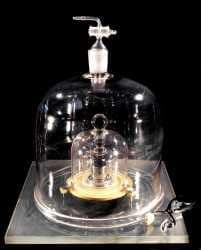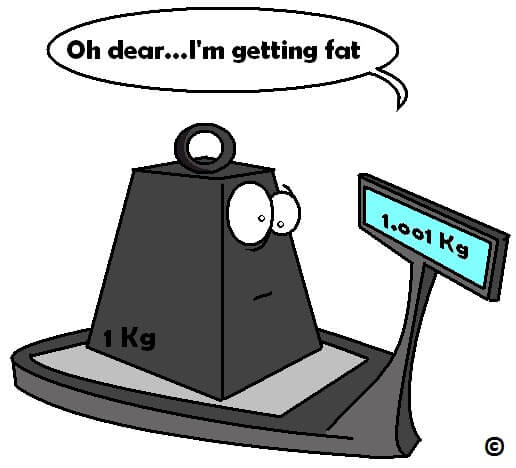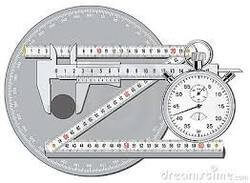The Not-So-Standard Kilogram
The kilogram is the base unit for mass, one of seven base units in the International System of Units (SI), currently defined as being equal to the mass of the International Prototype of the Kilogram (the IPK). The standard kilogram is an invaluable artifact not only ensuring that everyone around the world has the ability to weigh out the same amount of material, but also as a unit in which other important SI units are derived. This article will include a brief history of the kilogram, how the standard kilogram has been discovered over time to not be as standard as it was thought to be, and how this problem evolved.
Brief Origins
After the French Revolution in 1795, the new Republic adopted the idea of a metric standard for mass and length. Authorities at the time defined one gram (1/1000 of a kilogram) to have exactly the same mass as one cubic centimeter of water at the melting point of ice. With this definition, the kilogram (along with the meter) was manufactured shortly thereafter in 1799 out of platinum. These standards became the reigning standard for almost a hundred years.

However, other countries developed their own mass system and standards that were generally not compatible with the standards of other countries. So as the world’s economy grew, so did mass measurement problems. This disparity of mass standards between nations prompted several countries to sign the Meter Convention of 1875 to establish new international standards of mass and length. The new definition of the kilogram was then officially embodied in a small cylinder composed of 90% platinum and 10% iridium, and was given the title of International Prototype of the Kilogram (IPK) (the Standard Meter was also produced at this time).

A facsimile of the IPK under three glass bells. The glass bells serve to protect the artifact from the environment. Access to the actual IPK, located in the lower vault located in the basement of BIPM’s (Bureau International des Poids et Mesures, International Bureau of Weights and Measures) Pavillon de Breteuil in Saint-Cloud, is strictly controlled.
Conundrum
This single artifact is currently the exact definition of the kilogram. Copies of the IPK were made for other countries that signed the agreement, serving as national standards. Very occasionally, the national copies are compared and calibrated to the IPK, a process called “periodic verification”. Only three verifications so far have occurred, in the years of 1889, 1948, and 1989. The last of the three verifications confirmed a worrisome trend: compared to the IPK, the masses of all the national copies are fluctuating. In fact, on average the copies have gained around 50µg.

Because the comparisons are made with respect to the IPK, the national copies measured change in mass assumes that the mass of the IPK itself has stayed perfectly constant. But this can’t be the case: the first forty copies of the IPK were made of the exact same alloy as the IPK, they have been stored under similar conditions, and all have shown to have mass drift over time. This means the IPK must also experience mass drift over time.
While insignificant in everyday use for the average person, in this age where science requires increasingly precise measurements, this mass fluctuation needs to be resolved. The instability also undermines much of the SI system of measurement as the kilogram is used to derive many other SI units. There needs to be a new definition of the kilogram, one that is not dependent on a 138-year-old golf-ball-sized piece of metal, prone to wear and tear no matter how carefully it is stored or handled.
Reconciliation
Several alternative definitions have been proposed over the years, but as the 2018 deadline to submit a new official definition of the kilogram approaches, two methods have stood out.
One approach was to tie the definition of the kilogram to Avogadro’s constant. Known as the Avogadro Project and headed by the International Avogadro Coordination, the idea would be to define and delineate the kilogram as a softball-sized sphere of silicon atoms. Silicon was chosen because of the already available method to create defect-free, ultra-pure monocrystalline silicon. A sphere would be constructed from the ultra-pure boule and then finish-polished to exact dimensions, calculated from the properties of the silicon crystals. The sphere would then contain the exact number of silicon atoms that would make up a mass of one kilogram.

A facsimile of one of the silicone spheres. The real spheres must be handled with non-abrasive gloves as any scratches or deposits will change the mass of the sphere.

How does all this relate to the work we do here at Emery Pharma? Here, we strive to do the best work with state-of-the-art, fully calibrated, and qualified instruments and devices. That means all our measuring devices, such as our analytical balances, are regularly calibrated by certified calibration companies. These companies have standards that can be traced back to international standards, even all the way to the IPK. And while the recorded instability of the IPK has little impact on the work performed here, a new, more constant, definition of the kilogram can only be of benefit.
About the Author:
Hubert Lin holds a B.S. in Biomedical Engineering and a Master’s in Biotechnology. After working in both the Biology and Chemistry divisions, he now works as the Quality Assurance Associate at Emery Pharma.
References:
- National Institute of Standards and Technology U.S. Department of Commerce online. “Redefining the Kilogram.” Created 24 September 2014, updated 27 March 2017.
- Boutin, Chad. “NIST’s Newest Watt Balance Bring World One Step Closer New Kilogram.” National Institute of Standards and Technology U.S. Department of Commerce online. 21 June 2016.
- Haddad, F. Seifert, L.S Chao, S. Li, D.B. Newell, J.R. Pratt, C. Williams, and S. Schlamminger. “A precise instrument to determine the Planck constant, and the future kilogram, Review of Scientific Instruments.” June 21, 2016. DOI: 10.1063/1.4953825.
- G Girard 1994 Metrologia31 317, Bureau International des Poids et Mesures (BIPM), Pavillon de Breteuil, F-92312 Sèvres Cedex, France “International Prototype of the Kilogram.”

